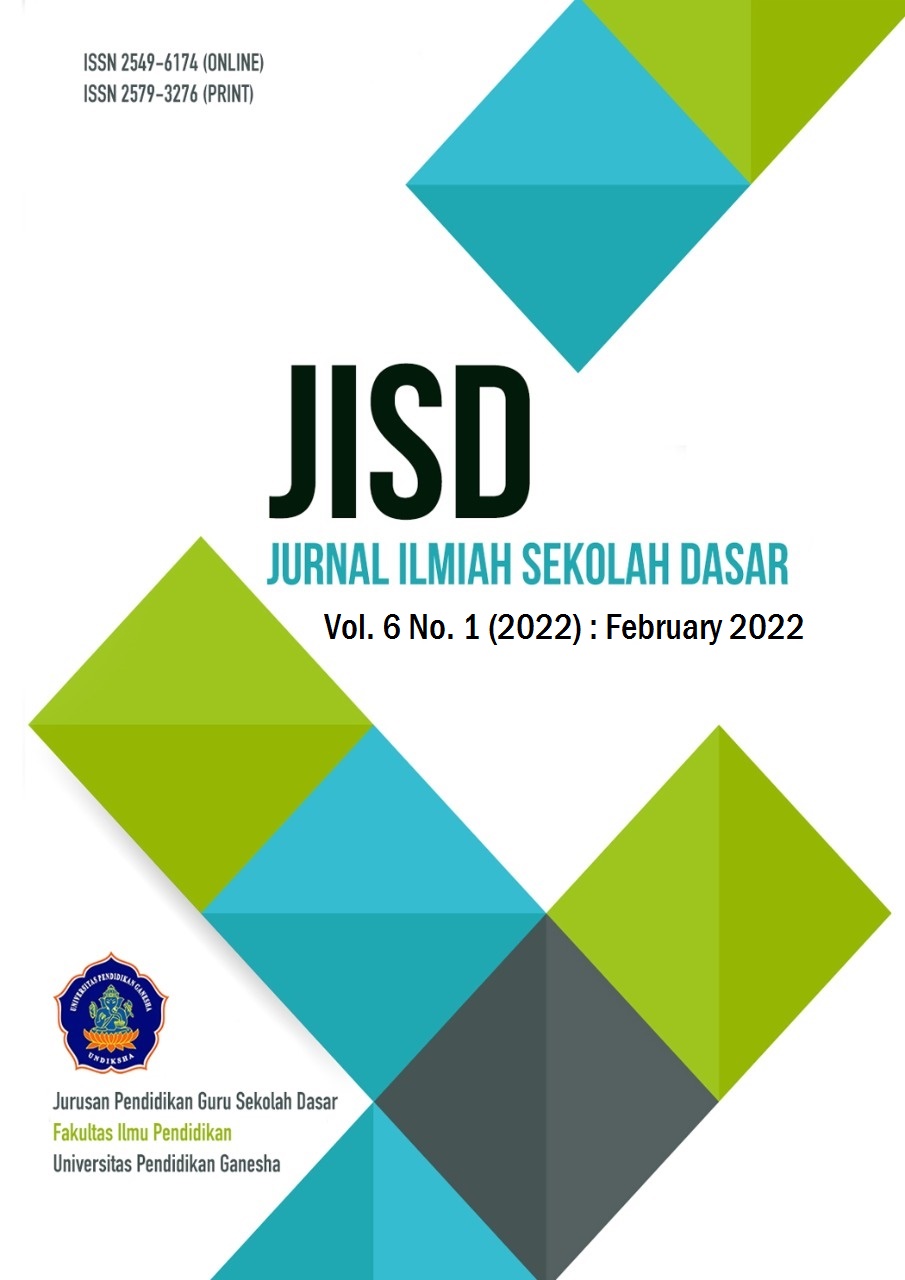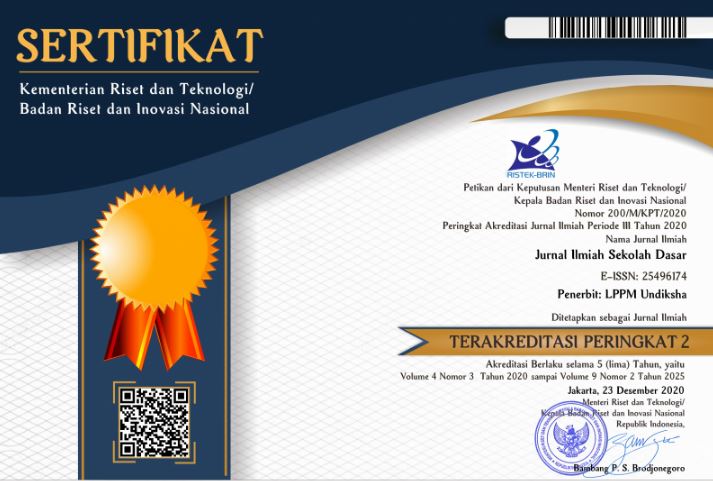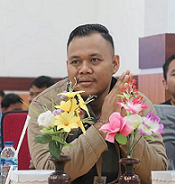Users’ Acceptance of Kumandang Interactive Reading Aloud Smartphone-Based Apps
DOI:
https://doi.org/10.23887/jisd.v6i1.43579Keywords:
Literacy, technology acceptance, smartphone, structural equation modelAbstract
In 21st century learning, the development of smartphone-based applications to support education, especially literacy, has become a basic need. This study aims to analyze the factors that factor in user acceptance of an Android-based application called Kumandang, Reading Aloud Activities. This type of research is survey research. The subjects of this study were ninety participants consisting of teachers, parents, and guardians. The research instrument used in this study was a questionnaire sheet. The technique of data collection is the distribution of questionnaires. The data analysis technique uses a structural equation model with the help of the SMARTPLS application. The study model uses UTAUT2, which consists of several indicators, including; Performance Expectations (PE), Business Expectations (EE), Social Influence (SI), Facilitation Conditions (FC), Price Value (PV), Hedonic Motivation (HM), and Habits of Behavioral Intentions (H). The results showed that business expectations (EE) related to the ease and convenience of using Kumandang positively affected user acceptance. In addition, hedonic motivation (HM) related to fun and entertainment also affects parents' intention to use the Kumandang application. The results also show that performance expectations (PE), social influences (SI), facilitating conditions (FC), habits (H), and price effects (PV) do not affect parents' acceptance of using the Kumandang application.
References
Afrianti, Y., & Wirman, A. (2020). Penggunaan Media Busy Book Untuk Menstimulasi Kemampuan Membaca Anak. Jurnal Pendidikan Tambusai, 4(2). https://doi.org/10.31004/jptam.v4i2.578.
Ahmadi, D. M. R. (2018). The Use of Technology in English Language Learning: A Literature Review. International Journal of Research in English Education, 3(2), 115–125. https://doi.org/10.29252/ijree.3.2.115. DOI: https://doi.org/10.29252/ijree.3.2.115
Alike, S., Commons, C., & License, A.-S. (2008). — Use Licence — Structural Equation Modelling : Guidelines for Determining.
Andriah, A., & Amir, M. F. (2021). Mobile Learning Based on Procedural and Conceptual Knowledge on Fractional for Elementary School. Jurnal Ilmiah Sekolah Dasar, 5(4), 567. https://doi.org/10.23887/jisd.v5i4.40819. DOI: https://doi.org/10.23887/jisd.v5i4.40819
Antee, A. (2021). Student perceptions and mobile technology adoption: implications for lower-income students shifting to digital. Educational Technology Research and Development, 69(1), 191–194. https://doi.org/10.1007/s11423-020-09855-5. DOI: https://doi.org/10.1007/s11423-020-09855-5
Artini, L. E. J., Magta, M., & Ujianti, P. R. (2019). Pengaruh Metode Membaca Dasar Bermediakan Big Book Terhadap Kemampuan Membaca Permulaan Anak Kelompok A*. Jurnal Pendidikan Anak Usia Dini Undiksha, 7(2), 195. https://doi.org/10.23887/paud.v7i2.18994. DOI: https://doi.org/10.23887/paud.v7i2.18994
Asih, P., & Sunarso, A. (2020). Implementation of Character Education to Improve the Students Discipline Through Habituation of Nadzam Asmaul Husna Recitation at Grade IV. Elementary School Teacher, 3(1). https://doi.org/10.15294/est.v3i1.28035. DOI: https://doi.org/10.15294/est.v3i1.28035
Astuti, R. F., & Istiarini, R. (2020). Upaya Meningkatkan Kemampuan Membaca Permulaan AnakUsia 5-6 Tahun Melalui Media Puzzle di PAUD Flamboyan Sukasari Kota Tangerang. Ceria: Jurnal Program Studi Pendidikan Anak Usia Dini, 8(2). https://doi.org/10.31000/ceria.v11i2.2338. DOI: https://doi.org/10.31000/ceria.v11i2.2338
Baba, J., & Rostam Affendi, F. (2020). Reading Habit and Students’ Attitudes Towards Reading: A Study of Students in the Faculty of Education UiTM Puncak Alam. Asian Journal of University Education, 16(1), 109. https://doi.org/10.24191/ajue.v16i1.8988. DOI: https://doi.org/10.24191/ajue.v16i1.8988
Bartel, A., & Hagel, G. (2014). Engaging students with a mobile game-based learning system in university education. International Journal of Interactive Mobile Technologies, 8(4), 957– 960. https://doi.org/10.3991/ijim.v8i4.3991. DOI: https://doi.org/10.3991/ijim.v8i4.3991
Bidin, S., & Ziden, A. A. (2013). Adoption and Application of Mobile Learning in the Education Industry. Procedia - Social and Behavioral Sciences, 90(InCULT 2012), 720–729. https://doi.org/10.1016/j.sbspro.2013.07.145. DOI: https://doi.org/10.1016/j.sbspro.2013.07.145
Cahyani, N. L. P., & Jayanta, I. N. L. (2021). Digital Literacy-Based Learning Video on the Topic of Natural Resources and Technology for Grade IV Elementary School. Jurnal Ilmiah Sekolah Dasar, 5(3), 538. https://doi.org/10.23887/jisd.v5i3.37918. DOI: https://doi.org/10.23887/jisd.v5i3.37918
Chandrathilaka, E. R. K., Baduge, S. K., Mendis, P., & Thilakarathna, P. S. M. (2021). Structural applications of synthetic fibre reinforced cementitious composites: A review on material properties, fire behaviour, durability and structural performance. Structures, 34. https://doi.org/10.1016/j.istruc.2021.07.090. DOI: https://doi.org/10.1016/j.istruc.2021.07.090
Chang, A. (2012). Utaut And Utaut 2: A Review And Agenda For Future Research. In Journal The WINNERS (Vol. 13, Issue 2). https://doi.org/10.21512/tw.v13i2.656. DOI: https://doi.org/10.21512/tw.v13i2.656
Chao, J. Y., Tzeng, P. W., & Po, H. Y. (2017). The study of problem solving process of e-book PBL course of atayal senior high school students in Taiwan. Eurasia Journal of Mathematics, Science and Technology Education, 13(3), 1001–1012. https://doi.org/10.12973/eurasia.2017.00654a. DOI: https://doi.org/10.12973/eurasia.2017.00654a
Christianti, M. (2013). Membaca dan Menulis Permulaan Untuk Anak Usia Dini. Jurnal Pendidikan Anak, 2(2). https://doi.org/10.21831/jpa.v2i2.3042. DOI: https://doi.org/10.21831/jpa.v2i2.3042
Cohn, J. (2016). “Devilish Smartphones” and the “Stone-Cold” Internet: Implications of the Technology Addiction Trope in College Student Digital Literacy Narratives. Computers and Composition, 42. https://doi.org/10.1016/j.compcom.2016.08.008. DOI: https://doi.org/10.1016/j.compcom.2016.08.008
Dakduk, S., Santalla-Banderali, Z., & Siqueira, J. R. (2020). Acceptance of mobile commerce in low-income consumers: evidence from an emerging economy. Heliyon, 6(11), e05451. https://doi.org/10.1016/j.heliyon.2020.e05451. DOI: https://doi.org/10.1016/j.heliyon.2020.e05451
Darnis. (2018). Aplikasi Montessori Dalam Pembelajaran Membaca, Menulis Dan Berhitung Tingkat Permulaan Bagi Anak Usia Dini. Jurnal Caksana : Pendidikan Anak Usia Dini, 1(1). https://doi.org/10.31326/jcpaud.v1i01.3. DOI: https://doi.org/10.31326/jcpaud.v1i01.3
Dorris, C., Winter, K., O’Hare, L., & Lwoga, E. T. (2021). Protokol: A systematic review of mobile device use in the primary school classroom and its impact on pupil literacy and numeracy attainment. Campbell Systematic Reviews, 17(2). https://doi.org/10.1002/cl2.1155. DOI: https://doi.org/10.1002/cl2.1155
Durán, L., Almeida, A. M., & Figueiredo-Braga, M. (2021). Digital audiovisual contents for literacy in depression: a pilot study with university students. Procedia Computer Science, 181. https://doi.org/10.1016/j.procs.2021.01.140. DOI: https://doi.org/10.1016/j.procs.2021.01.140
Gading, I. K., Magta, M., & Pebrianti, F. (2019). Pengaruh Metode Suku Kata Dengan Media Kartu Kata Bergambar Terhadap Kemampuan Membaca Permulaan. Mimbar Ilmu, 24(3). https://doi.org/10.23887/mi.v24i3.21417. DOI: https://doi.org/10.23887/mi.v24i3.21417
Gupta, B., Dasgupta, S., & Gupta, A. (2008). Adoption of ICT in a government organization in a developing country: An empirical study. Journal of Strategic Information Systems, 17(2), 140–154. https://doi.org/10.1016/j.jsis.2007.12.004. DOI: https://doi.org/10.1016/j.jsis.2007.12.004
Hair, Joe F., Sarstedt, M., Hopkins, L., & Kuppelwieser, V. G. (2014). Partial least squares structural equation modeling (PLS-SEM): An emerging tool in business research. European Business Review, 26(2), 106–121. https://doi.org/10.1108/EBR-10-2013-0128. DOI: https://doi.org/10.1108/EBR-10-2013-0128
Hair, Joseph F., Risher, J. J., Sarstedt, M., & Ringle, C. M. (2019). When to use and how to report the results of PLS-SEM. European Business Review, 31(1), 2–24. https://doi.org/10.1108/EBR-11-2018-0203. DOI: https://doi.org/10.1108/EBR-11-2018-0203
Hanif, M., Asrowi, A., & Sunardi, S. (2018). Students’ Access to and Perception of Using Mobile Technologies in the Classroom: the Potential and Challenges of Implementing Mobile Learning. Journal of Education and Learning (EduLearn), 12(4). https://doi.org/10.11591/edulearn.v12i4.8398. DOI: https://doi.org/10.11591/edulearn.v12i4.8398
Haris, C. A., WA, B. S., & Nasiri, A. (2019). Penerapan Model Utaut2 Untuk Mengevaluasi Aplikasi Ruang Guru. Jurnal Teknologi Informasi, 3(2), 192. https://doi.org/10.36294/jurti.v3i2.1085. DOI: https://doi.org/10.36294/jurti.v3i2.1085
Hariyanti, A. O., Hidayatullah, S., & Prasetya, D. A. (2020). Analysis of the Acceptance and Use of Mobile Banking Services Using the Unified Theory of Acceptance and Use of Technology (Case Study of Bank Jatim Pasuruan Branch). Research Journal of Advanced Engineering and Science, 5(1), 254–262.
Herlinda, F. (2014). Meningkatkan Kemampuan Membaca Kata Melalui Media Audio Visual Bagi Anak Slow Learner. Jurnal Ilmiah Pendidikan Khusus, 3(3), 53–63. https://doi.org/10.24036/jupe35000.64.
Irwanto, Taufik, Hernawan, & Rizal. (2019). Efektivitas Multimedia Interaktif Dan Mobile Learning Dalam Meningkatkan Hasil Belajar Siswa Pada Mata Pelajaran Seni Budaya. Jurnal Pendidikan Dan Kajian Seni, 4(1). https://doi.org/10.30870/jpks.v4i1.6845.
Islam, Z., Kim Cheng Low, P., & Hasan, I. (2013). Intention to use advanced mobile phone services (AMPS). Management Decision, 51(4), 824–838. https://doi.org/10.1108/00251741311326590. DOI: https://doi.org/10.1108/00251741311326590
Ivonne, H. P. A., Alberto, M. P. M., & Guadalupe, C. F. R. (2020). Augmented reality application for teaching basic operations with fractions of the same denominator. Journal of Computer Science, 16(7), 1042–1062. https://doi.org/10.3844/jcssp.2020.1042.1062. DOI: https://doi.org/10.3844/jcssp.2020.1042.1062
Jihad Mohaidat, M. A. B. (2013). Technology Readiness of School Teachers - An Empirical Study of Measurement and Segmentation. Industrial Engineering & Management, 02(04), 257–275. https://doi.org/10.4172/2169-0316.1000117. DOI: https://doi.org/10.4172/2169-0316.1000117
Knauer, H. A., Jakiela, P., Ozier, O., Aboud, F., & Fernald, L. C. H. (2020). Enhancing young children’s language acquisition through parent–child book-sharing: A randomized trial in rural Kenya. Early Childhood Research Quarterly, 50, 179–190. https://doi.org/10.1016/j.ecresq.2019.01.002. DOI: https://doi.org/10.1016/j.ecresq.2019.01.002
Kusuma, I. P. I. (2021). Tpack-related programs for pre-service english teachers: An in-depth analysis on efforts and issues of ict integration. Cakrawala Pendidikan, 40(1), 183–195. https://doi.org/10.21831/cp.v40i1.28820. DOI: https://doi.org/10.21831/cp.v40i1.28820
Lange, J., Heerdink, M. W., & Kleef, G. A. van. (2021). Reading emotions, reading people: Emotion perception and inferences drawn from perceived emotions. Current Opinion in Psychology, 43. https://doi.org/10.1016/j.copsyc.2021.06.008. DOI: https://doi.org/10.31219/osf.io/vsrjh
Le, T. T. H., Tran, T., Trinh, T. P. T., Nguyen, C. T., Nguyen, T. P. T., Vuong, T. T., Vu, T. H., Bui, D. Q., Vuong, H. M., Hoang, P. H., Nguyen, M. H., Ho, M. T., & Vuong, Q. H. (2019). Reading habits, socioeconomic conditions, occupational aspiration and academic achievement in Vietnamese junior high school students. Sustainability (Switzerland), 11(18), 1–29. https://doi.org/10.3390/su11185113. DOI: https://doi.org/10.3390/su11185113
Leong, L. Y., Hew, T. S., Tan, G. W. H., & Ooi, K. B. (2013). Predicting the determinants of the NFC-enabled mobile credit card acceptance: A neural networks approach. Expert Systems with Applications, 40(14), 5604–5620. https://doi.org/10.1016/j.eswa.2013.04.018. DOI: https://doi.org/10.1016/j.eswa.2013.04.018
Magni, M., Taylor, M. S., & Venkatesh, V. (2010). “To play or not to play”: A cross-temporal investigation using hedonic and instrumental perspectives to explain user intentions to explore a technology. International Journal of Human Computer Studies, 68(9), 572–588. https://doi.org/10.1016/j.ijhcs.2010.03.004. DOI: https://doi.org/10.1016/j.ijhcs.2010.03.004
Martins, M., Farias, J. S., Albuquerque, P. H. M., & Pereira, D. S. (2018). Adoption of technology for reading purposes: A study articles of e-books acceptance. Brazilian Business Review, 15(6), 568–588. https://doi.org/10.15728/bbr.2018.15.6.4. DOI: https://doi.org/10.15728/bbr.2018.15.6.4
Mifsud, C. L., Georgieva, R., & Kucirkova, N. (2021). Parent-child joint reading of digital books in bilingual families in Malta. International Journal of Educational Research, 109(July), 101844. https://doi.org/10.1016/j.ijer.2021.101844. DOI: https://doi.org/10.1016/j.ijer.2021.101844
Narahawarin, M., & Winarsih, S. (2019). Gerakan Literasi Sekolah Di Sd Yppk Yos Sudarso Kuper Sebagai Upaya Menyukseskan Program Gerakan Literasi Nasional. Musamus Journal of Language and Literature, 1, 22–32. https://doi.org/10.35724/mujolali.v1i2.1460. DOI: https://doi.org/10.35724/mujolali.v1i2.1460
Narayan, V., Herrington, J., & Cochrane, T. (2019). Design principles for heutagogical learning: Implementing student-determined learning with mobile and social media tools. Australasian Journal of Educational Technology, 35(3), 86–101. https://doi.org/10.14742/ajet.3974. DOI: https://doi.org/10.14742/ajet.3941
Nordhoff, S., Louw, T., Innamaa, S., Lehtonen, E., Beuster, A., Torrao, G., Bjorvatn, A., Kessel, T., Malin, F., Happee, R., & Merat, N. (2020). Using the UTAUT2 model to explain public acceptance of conditionally automated (L3) cars: A questionnaire study among 9,118 car drivers from eight European countries. Transportation Research Part F: Traffic Psychology and Behaviour, 74, 280–297. https://doi.org/10.1016/j.trf.2020.07.015. DOI: https://doi.org/10.1016/j.trf.2020.07.015
Nudiati, D. (2020). Literasi Sebagai Kecakapan Hidup Abad 21 Pada Mahasiswa. Indonesian Journal of Learning Education and Counseling, 3(1), 34–40. https://doi.org/10.31960/ijolec.v3i1.561. DOI: https://doi.org/10.31960/ijolec.v3i1.561
Omland, M. (2021). Technology-aided meaning-making across participation structures: interruptions, interthinking and synthesising. International Journal of Educational Research, 109(July 2020), 101842. https://doi.org/10.1016/j.ijer.2021.101842. DOI: https://doi.org/10.1016/j.ijer.2021.101842
Paratore, J. (2011). Parents and Reading: What Teachers Should Know About Ways to Support Productive Home–School Environments (pp. 406–424). https://doi.org/10.1598/0829.16. DOI: https://doi.org/10.1598/0829.16
Peura, P., Aro, T., Räikkönen, E., Viholainen, H., Koponen, T., Usher, E. L., & Aro, M. (2021). Trajectories of change in reading self-efficacy: A longitudinal analysis of self-efficacy and its sources. Contemporary Educational Psychology, 64(January). https://doi.org/10.1016/j.cedpsych.2021.101947. DOI: https://doi.org/10.1016/j.cedpsych.2021.101947
Pindeh, N., Suki, N. M., & Suki, N. M. (2016). User Acceptance on Mobile Apps as an Effective Medium to Learn Kadazandusun Language. Procedia Economics and Finance, 37(16), 372–378. https://doi.org/10.1016/s2212-5671(16)30139-3. DOI: https://doi.org/10.1016/S2212-5671(16)30139-3
Piper, B., Zuilkowski, S. S., Kwayumba, D., & Oyanga, A. (2018). Examining the secondary effects of mother-tongue literacy instruction in Kenya: Impacts on student learning in English, Kiswahili, and mathematics. International Journal of Educational Development, 59(July 2017), 110–127. https://doi.org/10.1016/j.ijedudev.2017.10.002. DOI: https://doi.org/10.1016/j.ijedudev.2017.10.002
Piper, B., Zuilkowski, S. S., Kwayumba, D., & Strigel, C. (2016). Does technology improve reading outcomes? Comparing the effectiveness and cost-effectiveness of ICT interventions for early grade reading in Kenya. International Journal of Educational Development, 49, 204–214. https://doi.org/10.1016/j.ijedudev.2016.03.006. DOI: https://doi.org/10.1016/j.ijedudev.2016.03.006
Pratama, H., Azman, M. N. A., Gulzhaina K. Kassymova, & Duisenbayeva, S. S. (2020). The Trend in Using Online Meeting Applications for Learning During the Period of Pandemic COVID-19 : A Literature Review. Journal of Innovation in Educational and Cultural Research, 1(2), 58–68. https://doi.org/10.46843/jiecr.v1i2.15. DOI: https://doi.org/10.46843/jiecr.v1i2.15
Rajab, H., & Al-Sadi, A. (2015). An Empirical Study of Reading Habits and Interest of Saudi University EFL Learners. International Journal of Linguistics, 1–17. https://doi.org/10.5296/ijl.v7i2.7034. DOI: https://doi.org/10.5296/ijl.v7i2.7034
Richardson, M., Gorley, M., Wang, Y., Aiello, G., Pintsuk, G., & Gaganidze, E. (2021). Technology readiness assessment of materials for DEMO in-vessel applications. Journal of Nuclear Materials, 550. https://doi.org/10.1016/j.jnucmat.2021.152906. DOI: https://doi.org/10.1016/j.jnucmat.2021.152906
Riyanto, R., Amin, M., Suwono, H., & Lestari, U. (2020). The New Face of Digital Books in Genetic Learning: A Preliminary Development Study for Students’ Critical Thinking. International Journal of Emerging Technologies in Learning (IJET), 15(10), 175. https://doi.org/10.3991/ijet.v15i10.14321. DOI: https://doi.org/10.3991/ijet.v15i10.14321
Rusli, M., & Antonius, L. (2019). Meningkatkan Kognitif Siswa SMAN I Jambi Melalui Modul Berbasis E-Book Kvisoft Flipbook Maker. Jurnal Sistem Komputer Dan Informatika (JSON), 1(1), 59. https://doi.org/10.30865/json.v1i1.1397. DOI: https://doi.org/10.30865/json.v1i1.1397
Saputra, M., Maulidya Izzati, B., & Rahmadiani, J. (2021). The Acceptance of Government Resource Planning System Using Unified Theory of Acceptance and Use of Technology 2. Journal of Information System), 17(1), 1–19. https://doi.org/10.21609/jsi.v17i1.1010. DOI: https://doi.org/10.21609/jsi.v17i1.1010
Sobakhah, L. B., & Afakhrul Masub Bachtiar. (2019). Pengembangan Media Pop Up Book Untuk Pembelajaran Membaca Puisi Kelas I SD. JTIEE (Journal of Teaching in Elementary Education), 3(1), 62–70. https://doi.org/10.30587/jtiee.v3i1.1129. DOI: https://doi.org/10.30587/jtiee.v3i1.1129
Suartama, I. K., Setyosari, P., Sulthoni, & Ulfa, S. (2019). Development of an instructional design model for mobile blended learning in higher education. International Journal of Emerging Technologies in Learning, 14(16), 4–22. https://doi.org/10.3991/ijet.v14i16.10633. DOI: https://doi.org/10.3991/ijet.v14i16.10633
Susanti, N., Yennita, Y., & Azhar, A. (2020). Development of Contextual Based Electronic Global Warming Modules Using Flipbook Applications as Physics Learning Media in High Schools. Journal of Educational Sciences, 4(3), 541. https://doi.org/10.31258/jes.4.3.p.541-559. DOI: https://doi.org/10.31258/jes.4.3.p.541-559
Syahrowardi, S., & Permana, A. H. (2016). Desain Handout Multimedia Menggunakan 3D Pageflip Professional untuk Media Pembelajaran pada Sistem Android. Jurnal Penelitian & Pengembangan Pendidikan Fisika, 2(1), 89–96. https://doi.org/10.21009/1.02113. DOI: https://doi.org/10.21009/1.02113
Tambunan, L. R., Siregar, N. A. R., & Susanti, S. (2020). Implementasi E-book Berbasis Smartphone pada Materi Polinomial di Kelas XI SMA Negeri 4 Tanjungpinang. Jurnal Anugerah. https://doi.org/10.31629/anugerah.v2i2.2521. DOI: https://doi.org/10.31629/anugerah.v2i2.2521
Teo, T., & Noyes, J. (2014). Explaining the intention to use technology among pre-service teachers: a multi-group analysis of the Unified Theory of Acceptance and Use of Technology. Interactive Learning Environments, 22(1), 51–66. https://doi.org/10.1080/10494820.2011.641674. DOI: https://doi.org/10.1080/10494820.2011.641674
Tong, F., Zhang, H., Zhen, F., Irby, B. J., & Lara-Alecio, R. (2021). Supporting home literacy practices in promoting Chinese parents’ engagement in their children’s English education in low-SES families: An experimental study. International Journal of Educational Research, 109(April), 101816. https://doi.org/10.1016/j.ijer.2021.101816. DOI: https://doi.org/10.1016/j.ijer.2021.101816
Varga, E. I. (2020). How does the internet influences the readers’ behavior. Procedia Manufacturing, 46, 949–956. https://doi.org/10.1016/j.promfg.2020.05.013. DOI: https://doi.org/10.1016/j.promfg.2020.05.013
Viswanath, V., G, M. M., B, D. G., & D, D. F. (2006). Human Acceptance of Information Technology. International Encyclopedia of Ergonomics and Human Factors, Second Edition - 3 Volume Set, 27(3), 425–478. https://doi.org/10.1201/9780849375477.ch230. DOI: https://doi.org/10.1201/9780849375477.ch230
Wang, H.-Y., Liao, C., & Yang, L.-H. (2013). What Affects Mobile Application Use? The Roles of Consumption Values. International Journal of Marketing Studies, 5(2), 1–14. https://doi.org/10.5539/ijms.v5n2p11. DOI: https://doi.org/10.5539/ijms.v5n2p11
Wang, Y., & Sun, S. (2010). Assessing beliefs, attitudes, and behavioral responses toward online advertising in three countries. International Business Review, 19(4), 333–344. https://doi.org/10.1016/j.ibusrev.2010.01.004. DOI: https://doi.org/10.1016/j.ibusrev.2010.01.004
Wiana, P. J. A. E., Gading, I. K., & Kusmariyatni, N. (2017). The Application of Authentic Assessment to Improve the Learning Outcomes of Science in the fourth-grade students of SD Negeri 2 Pupuan. Journal of Education Research and Evaluation, 1(2), 106. https://doi.org/10.23887/jere.v1i2.9841. DOI: https://doi.org/10.23887/jere.v1i2.9841
Widyowati, F. T., Rahmawati, I., & Priyanto, W. (2020). Pengembangan Media Pembelajaran Membaca Mengeja Berbasis Aplikasi untuk Kelas 1 Sekolah Dasar. International Journal of Community Service Learning, 4(4), 332–337. https://doi.org/10.23887/ijcsl.v4i4. DOI: https://doi.org/10.23887/ijcsl.v4i4.29714
Winarti, W., & Suryana, D. (2020). Pengaruh Permainan Puppet Fun terhadap Kemampuan Membaca Anak Usia Dini. Jurnal Obsesi : Jurnal Pendidikan Anak Usia Dini, 4(2). https://doi.org/10.31004/obsesi.v4i2.462. DOI: https://doi.org/10.31004/obsesi.v4i2.462
Wu, T.-T., & Chen, A.-C. (2018). Combining e-books with mind mapping in a reciprocal teaching strategy for a classical Chinese course. Computers & Education, 116. https://doi.org/10.1016/j.compedu.2017.08.012. DOI: https://doi.org/10.1016/j.compedu.2017.08.012
Yudhiantara, R. A., & Saehu, A. (2017). Mobile-Assisted Language Learning (MALL) in Indonesian Islamic Higher Education. IJELTAL (Indonesian Journal of English Language Teaching and Applied Linguistics), 2(1), 21–31. https://doi.org/10.21093/ijeltal.v2i1.52. DOI: https://doi.org/10.21093/ijeltal.v2i1.52
Zhu, S. (2017). The Corporate Financial Forecasting Based on Least Squares Support Vector Machines Methods. Technology and Investment, 08(03), 151–157. https://doi.org/10.4236/ti.2017.83013 . DOI: https://doi.org/10.4236/ti.2017.83013
Downloads
Published
How to Cite
Issue
Section
License
Copyright (c) 2022 Ni Komang Dwi Eka Yuliati, Made Hery Santosa, Setya Chendra Wibawa

This work is licensed under a Creative Commons Attribution-ShareAlike 4.0 International License.
Authors who publish with the Journal Ilmiah Sekolah Dasar agree to the following terms:
- Authors retain copyright and grant the journal the right of first publication with the work simultaneously licensed under a Creative Commons Attribution License (CC BY-SA 4.0) that allows others to share the work with an acknowledgment of the work's authorship and initial publication in this journal.
- Authors are able to enter into separate, additional contractual arrangements for the non-exclusive distribution of the journal's published version of the work (e.g., post it to an institutional repository or publish it in a book), with an acknowledgment of its initial publication in this journal.
- Authors are permitted and encouraged to post their work online (e.g., in institutional repositories or on their website) prior to and during the submission process, as it can lead to productive exchanges, as well as earlier and greater citation of published work. (See The Effect of Open Access)











